
An eruption of stories exploded on social media on Oct. 6, 2020 when Eddie Van Halen had lost his battle with cancer. This news about this guitarist extraordinaire — of one of the most quintessential heavy rock groups with the same name, Van Halen — hit hard. From their first concert tour in 1978 to their final show in 2015, many in our industry working with the band became part of the extended “VH family.” They met lifelong friends on the crew. A slew of our industry’s top lighting designers and directors translated their music into visual productions that have since blown the minds and burned into the memories of fans around the world.

PLSN contacted Van Halen’s touring lighting designers, directors and crew to share their memories as viewed through the rose-colored glasses of time.
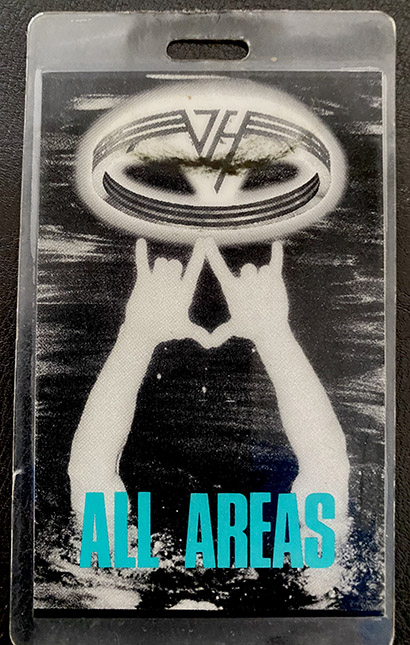
David Davidian: VH Lighting Designer/Director, 1986-1993.
Tours: 5150 (1986), Monsters of Rock (1988), OU812 (1989), and the U.S. leg of For Unlawful Carnal Knowledge (1991-1992)
David’s story: I met Van Halen during their first nationwide concert tour in 1978. I was out as the lighting crew chief with that tour’s headliner, Journey, and VH were the support act on the bill playing first, before Ronnie Montrose. When David Lee Roth left in 1985, I came to VH through Sammy Hagar and Sammy’s manager, Ed Leffler. I’d been with Sammy since 1981 and luckily had Sam and Ed’s trust in me. I had known Pete Angelus, Van Halen’s designer, up until the time I took over, and had a good relationship with him. Pete and I had met in 1978 during that Journey tour and had run into each over in the following years a few times. Pete’s design work with Van Halen was brilliant and groundbreaking always; I knew I had big shoes to fill.
I remember going up to the 5150 recording studio for the first time to meet the band during the 5150 recording sessions. I was both curious and concerned to hear what had been created. The band played two of the new tracks for me, “Good Enough” and “Dreams,” and I happily said to myself: “This is going to be just fine!”
Alex was involved in all the show’s production and design elements, although every design and production model was presented to the band for their input. All the Van Halen designs were a collaboration between me and set designer Ian Knight. We brainstormed ideas — Ian came up with final stage drawings and stage models and I the lighting design drawings. Ian was my partner on all those tours I was on; he was brilliant and invaluable to all of those productions.
I thought the 5150 tour was a brilliant tour; I enjoyed it start to finish. We designed a clean stage, a huge lighting system, and all the amps were all hidden behind grating that ran the length of the stage, also putting the band’s cabinets in holes under the main stage floor. Monsters of Rock in 1988 continued to use the high quantity system of PAR cans that Van Halen was famous for. The OU812 tour’s indoor lighting system featured five big triangles with a circular center truss shape that created a star pattern. In those triangles, we used PAR cans to spell out the letters “OU812.” It was a pretty system with a huge footprint. That tour was the first time VH had used moving lights, which got some resistance from management who favored the traditional PAR can look. I ended up with about 900 PAR cans and only 25 of the VL1s, but the seed had been planted. The look of the show changed in 1991 for the For Unlawful Carnal Knowledge tour, when we were able to switch to an automated lighting fixture concept, and we never looked back.
Eddie and the entire band always had my back, they were fully involved in part of the show design and supported me 150 percent at all times and I was always grateful for that. On a personal note, I was always touched by Eddie and Alex’s relationship as brothers; you always knew that, no matter what, that bond was so deeply rooted in love and mutual respect that it was impenetrable. Overall, I think we delivered some great shows, created some good memories, and I hope that the concert-going public enjoyed it. That was always the band’s and my first goal and end-game objective. Van Halen was a wonderful experience. It was a designer’s dream, and I was so lucky and blessed that it had come true for me.
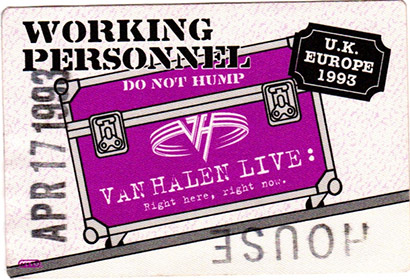
John Featherstone: VH co-designer with LeRoy Bennett and Touring Lighting Director for Live: Right Here Right Now (1993)
John’ s story: Eddie had a reputation for being a great guy — easygoing, down-to-earth, friendly, relaxed; a really decent guy who felt fortunate and blessed to play for millions of people. This band, from Pasadena, CA, was the L.A.-version of the American dream.
When I started working with them, they’d already gotten the mega-show idea out of their system. They were always zigging when others zagged. They wanted something new and different, and asked where technology was going. That is what LeRoy focused on — the balance of the old and the new: embracing their rich past of live entertainment and also looking forward to make this new and distinctive. This was one of the first tours to take out VL5s, and the blend of a traditional PAR can look with a moving and color changing capability was perfect.
When you went to see Van Halen, there was an expectation of how it would make you feel. It was a blood-pumping, heart-racing American band playing loud, driving music in a way that was powerful, but with moments of quiet and restraint. It was curated by the band. To take the audience on a journey, the visuals needed to support that, too. You couldn’t deliver a VH show with two straight trusses. You needed mass and oomph, otherwise the music would eclipse what you were doing visually. The design that LeRoy Bennett spearheaded was based on the way we wanted the audience to feel: full-on driving sensory overload. There was an amazing counterpoint to that — quiet and thoughtful and cerebral and those moments made the high higher and the loud louder. It was a sense of the journey that they would take the audience on. Every peak was slightly higher than the peak before. We were able to match that visually.
With Eddie’s jumps and scissor kicks, there was room for exploration and improvisation and the unexpected, so you knew well you had to keep on your toes. It was a show that was exciting every night and was a lot of fun to run. Not only was it fabulous, but it was running a real show, not watching timecode numbers run by. It was running a good, old-fashioned rock show, which I still like to do. Surfing on the wave of the energy made every show a unique experience in its own way. Not wishing to sound arrogant, but I will always remember those amazing nights when everything clicked and you felt like you were almost part of the band — when the 300 feet between the mix position and stage seemed to “disappear.” It felt like (Vari-Lite programmer) Nick Barton and I were on the stage with the guys. It was absolutely fabulous.
Eddie, the same man doing scissor kicks creating this amazing music, was also a deeply committed family guy — his son Wolfie was young then, too. My fondest memory was when my wife Kathy and I went to see them later on the Balance tour, and our daughter Hailey was with us, maybe 18 months old, and she was playing backstage with Eddie, just running round and laughing — pure joy, both of them. Eddie was a nice, kind, gentle soul, and he knew what was important, he knew families mattered. He loved multigenerational audiences. I’m sure the notion of adding another Van Halen to the band when Wolfgang joined was really special for Eddie.
I will always relish working for Van Halen and traveling the world. They were so into what they did and so grateful, it was hard to not have a good day, every day. Eddie Van Halen changed rock music forever, and his legacy lives on in his music.
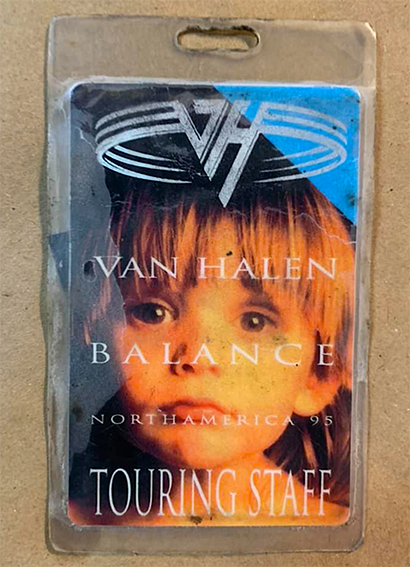
Chris Stuba: Tech on VH Balance (1995)
Chris’ story: Twenty-five years ago, I started working on the Van Halen Balance tour. VH felt very much like a gang. I was proud to be a small part. Most roadies that have done Van Halen will tell you that. There were some amazing people and some truly amazing times. Tours usually happen so fast sometimes you don’t really get to know somebody but here, some 25 years later, I am still in touch with most of these guys.
In Jacksonville, FL, a main I-beam at the venue buckled and rolled during load-in. The city was responsible for engineering the rigging — you would give them your plot, and they would determine where the points were and physically rig the show from bucket trucks. The lighting rig was covered in Spandex, so it was hard to see anything from the ground. Peter Feher (a.k.a., “Grandpa Roadie”) climbed on top of the truss every day to ride it up so that he could see all the motors and the lighting pods. Once the truss started moving out, the entire upstage right portion of the rigging came melting down. A 20-foot house I-beam had collapsed under the weight and rolled and dipped down. The entire lighting rig fell on the upstage right side. A Cyberlight took the entire weight of the rig, giving Jerry Reinhardt enough space to roll out from underneath the rig before being trapped. We did a scaled-down show that night.
Amphitheaters were extremely hot that year, and the Gorge was brutal. When we got to Denver, we played Fiddler’s Green. It was raining and cold while we loaded in, and by lunchtime, it turned to snow. By showtime, there were nine inches of snow on the ground. It was an amazing look for the lighting system. When Mac Mosier did sweeps out to the house, it just looked fantastic — that was some great atmospherics. There were snowball fights on stage, but at the end of the night, the trucks had a tough time getting out.
In August, the band filmed two performances at Molson Amphitheater in Toronto. I ran a Compulite Animator with Intellabeams and used WYSIWYG for the first time. Adding fixtures to a touring show is difficult enough, but it was a daylight load-in, so it was almost impossible to focus. After the show, Mac and I started doing notes that ran into the night. The band sent Mac and I a limo to get back to the hotel. Nice.
We got back the next morning and still had plenty to do. Around lunchtime, production manager Frank Stedtler called everybody into the production area and told them if they did not get on this luxury yacht that the band had rented, they would be fired. The clock was ticking as the crew cruised around Lake Ontario. Mac and I were a little stressed, but it turned out great. It was really just was one of those things that the band did. They really looked out for you, we looked out for them, and the shows were always great.
I knew that Eddie had been sick, I just always felt I would see him again one more time.
I will miss him. The world was a better place with him in it.
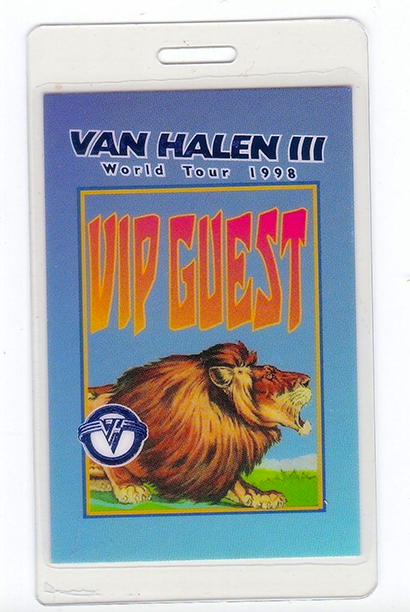
LD Howard Ungerleider: Designer/operator of Van Halen III (1998)
Howard’s story: It was weird how I got to be the designer. The band was trying to create a circus tent, and they asked designers to submit designs. Tour manager Scotty Ross called and said, “The guys asked me to have you send in a design; you are one of probably 15 people going for this.” So I asked, “Is there money in it?” He said, “No, everyone is sending in a design.” I said, “I can’t do that, I don’t design for free and someone can take those designs and use it, so I will pass.” Four or five days later, Scotty calls again. He said, “Alex wants me to fly you into L.A. and have a meeting with you. He is really upset. He wants to meet the person who passed on Van Halen. He just said to put you on the plane tomorrow.” So I flew in and met with Alex at the 5150 Studio. Alex asked, “So you are the f… who passed on Van Halen? Tell me why you passed on the biggest band in the world?” I asked, “Will Van Halen do a free concert for me in Toronto?” He said, “Hell no.” I said, “That’s your answer.” He said, “Oh, you’re that kind of guy.” After more questions, he said, “I sort of like you. I’m going to hire you. Just don’t use those mushy colors like you do with Rush — the pinks and magentas.” I said, “Fine.”
I basically designed a rig that had a duck web, like duck feet. In between the trusses were huge webbings onto which I could project. At times, it looked like a Romulan battle cruiser, some times a circus tent, others times a concert hall. It was a fun rig. Another thing that was different: I needed live recordings to program my shows. The band never had to do that for anyone, and Alex questioned me about my unusual request. I asked, “Do you want a show that sucks or is spectacular? If you give me the time at night and music without distractions, you will have a superior show.” And I got it.
There was no choreography — Eddie jumped to no end. I used spotlights on everyone and covered each musician in lighting from all different angles, so no one was ever out of the spotlight. I usually hit it from at least three directions minimum for each of the guys in the band, so they always had cross lighting and back lighting.
Alex was the business guy. Eddie was a sweetheart; one of the nicest guys, so down-to-earth. He would hang outside the hotels to meet with fans. I respect him for that. The “no brown M&Ms” mandate in the contract rider was gone at that point. But in the dressing room, there were always two banana cream pies, and every night Eddie would come back and take the whole pie and put it in his face. I think cream pies were on the rider for this one.
That was one of my favorite tours. Rush was a given. But Van Halen was just a great, good-vibe experience. Every day was a lot of fun. Eddie had a great sense of humor. I got along with everyone so well, they called me back to do the next tour, but Rush were going out at the same time, so I had to tell Alex I was committed. It was a lot of fun, lot of good times.
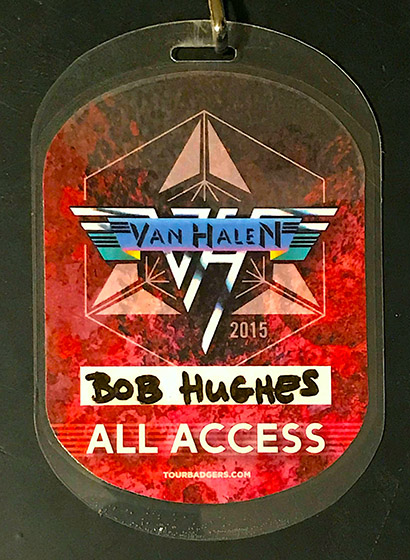
Bob Hughes: Stage designs/construction (2004-2015)
Bob’s story: I’ve had the pleasure of personally being a part of the VH tour stage designs and/or construction since 2004. As the years went on, the band took me along to help interpret their vision and create the reality. (I did get Butch Allen’s blessing prior to cutting out the production designer.) That last shed tour in 2015 had a fabulous drum riser as the centerpiece, which Al [Alex Van Halen] and Dave [David Lee Roth] and I designed on the patio at Dave’s house. The lighting rig was my homage to the planned final venue of the tour, the Hollywood Bowl. It started with the Jimmy Kimmel Live performance on Hollywood Boulevard when I was just trying to change up the “front truss/back truss” industry standard for a small stage event.
Ed didn’t get too involved in the design, but did have some input in the past couple of tours regarding set and lighting. I think the entire band’s biggest negative thing was the flashy disco style of lighting design and operation. They always pushed toward trying to create a mood and be more theatrical with the scenes. Since (lighting designer) Pete Angelus left with Dave, they got out of the massive 1,000-lamp rigs and tried to settle into a situation that helped augment the music, but also helped create income rather than just cash flow for them. I, however, missed the show’s larger-than-life spectacle we all came to know and love as the Mighty Van Halen.
The first album in 1978 was a turning point for me, and over the years, I had the good fortune to not only to see them live in concert, but enjoy countless hours of private rehearsals and get to know them on a personal level, in and out of the room. So many good times and memories for me. They’ve been my favorite band since 1978, and I have certainly lived a surreal life!
Eddie’s passing is such a huge personal and historical loss to the world. That guy told a story with his guitar style and playing. Those who imitated him — including me — are just telling jokes. It was always hard for me not to become “fan boy” around him.


